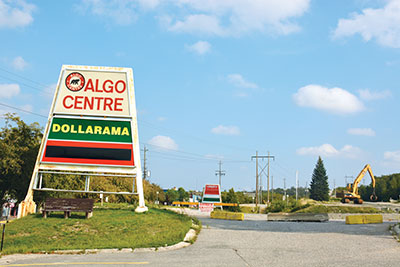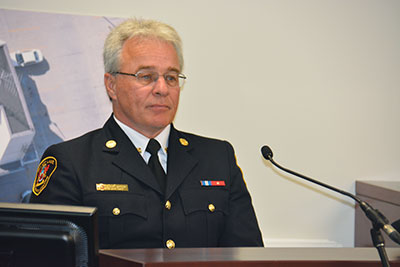
Features
Hot topics
Incident reports
Elliot Lake analysis
When former premier of Ontario Dalton McGuinty called for an inquiry into the collapse of the Algo Centre mall in Elliot Lake, Ont., and the emergency response to it
January 7, 2014
By
Laura King
When former premier of Ontario Dalton McGuinty called for an inquiry into the collapse of the Algo Centre mall in Elliot Lake, Ont., and the emergency response to it, there was a presumption among residents, reporters, and some politicians and bureaucrats, that things had gone terribly wrong with the rescue-turned-recovery operation.
 |
|
| The Elliot Lake inquiry into the collapse of the Algo Centre mall ran 117 days; there were 125 witnesses and 9,000 exhibits. The centre was levelled and a new mall is being built but is behind schedule. Photos by Laura King
|
Eighteen months later, after 39 days of testimony during the rescue and emergency management portion of the inquiry and two days of talks in Ottawa with hand-picked participants to help Commissioner Paul Belanger shape his recommendations – which are expected by October – it is clear that, in fact, very little went wrong.
Indeed, as lawyer John Saunders has said in court and in presentations, Elliot Lake Fire Chief Paul Officer executed a textbook operation in the small, northern Ontario town where two women died on June 23, 2012, buried under slabs of concrete after the roof-top parking garage collapsed as a result of poor planning and years of neglect by the mall’s owners.
But as Officer told his peers at the Ontario Association of Fire Chiefs mid-term meeting in November in reference to the incident, the response, the inquiry, the stress, the microscope under which his department’s and the province’s actions were probed, the reaction of townspeople and politicians, and the myriad armchair quarterbacks, “Even though you do things right, they can still go wrong.”
In testimony, several inquiry witnesses from fire – including Officer – the Ontario Provincial Police (OPP), Ontario’s Ministry of Community Safety and Toronto’s Heavy Urban Search and Rescue (HUSAR) team said communication and command were issues in Elliot Lake. But for whom?
Certainly – according to the testimony – command was a problem for the OPP; its agency-specific incident-command system didn’t jibe with methods used by the fire department or the HUSAR team, and its members on scene weren’t willing – or able – to adapt.
And it was clear from testimony that communication among agencies at the highest levels would have been better had the OPP’s rescue team, known as UCRT, had a senior officer on scene and in the command tent to liaise with fire and HUSAR; that officer was out of town and there was no one else available or qualified.
(Officer never called UCRT. Indeed, as Saunders said at the mid-term, UCRT self deployed. In fact, Officer didn’t even know the team existed. “The OPP needs to learn to fit into incident command better,” Saunders said. “Sometimes we have silos.”)
As for communication with reporters – and, by extension, the public – many who sat through the testimony firmly believe that had officials revealed early on that there were just two people in the rubble and that at least one was dead (CBC’s The National reported that there were up to 30 people trapped), the ensuing media frenzy, the townspeople’s frustration, the second-guessing and the inquiry itself would never have happened.
Chief Officer wanted those details disseminated; others in the town’s emergency- management hierarchy disagreed.
“If they had done what Paul Officer wanted,” Saunders said, “the inquiry might not have happened.”
As Officer noted, it wasn’t his call.
“I put it on the table, and it went around and the decision was made.”
What will come out of the rescue portion of the inquiry? Was it worth the innumerable hours of lawyers’ time and months of duress for Chief Officer, his family and his fire department?
. . .
Commissioner Paul Belanger has 9,915 exhibits, 117 days of testimony, 31 final summations, 20 sets of answers to questions posed before the roundtable talks, and four days of roundtable discussions to consider before making his recommendations on potential changes to the way agencies in Ontario respond to rescues. (Phase I of the inquiry dealt with the collapse itself and the reasons for it, and Belanger’s recommendations will also address those issues.)
 |
|
| Signs of support for the people of Elliot Lake and its firefighters appeared during the inquiry.
|
The Ontario Association of Fire Chiefs (OAFC) wants few changes because, for the most part, it believes the system isn’t broken but needs some modifications, none of which has anything to do with the Elliot Lake Fire Department’s response to or command of the incident.
Mainly, the OAFC wants to ensure that other agencies recognize that in a rescue, the fire chief is the incident commander, and that legislation is amended to remove the Ministry of Labour’s authority to shut down a rescue given that the fire chief is the IC and is keenly aware of all health and safety protocols and the risks to personnel. (There was considerable confusion on scene in Elliot Lake about the MOL’s authority to stop a rescue.)
The OAFC is also concerned that whatever recommendations Belanger makes work for rural, volunteer departments and large, urban centres. That means recommendations that require municipalities to spend money or add resources will not fly. “Not all of those firefighters are going to become rescue specialists,” Saunders told the commissioner in his final summation.
“Not all of the municipalities are going to train, equip and allow their firefighters to develop a level of expertise which will be utilized in every situation, so we need to be practical in terms of what we come up with.”
The province, in its submission (which includes the OPP and the MOL), says it will work to bolster the level of support it provides to municipalities during incidents and will identify communication leads and protocols for critical incidents. It also says it will review the provincial incident-management system with the groups that participated in its development – including the OAFC – to develop a better culture of compliance. (The province said similar things following the ice storm in 1998, the Y2K rollover and the events of post 9-11. Some in emergency management circles say nothing has changed or improved; many of the same problems experienced during the ice storm – particularly command, control and communication – were encountered in Elliot Lake.)
The province, however, disagrees with the OAFC’s position on the role of the Ministry of Labour. MOL inspectors, it says, can stop a rescue if they believe there are safety risks, and the legislation is clear.
The OAFC has asked Belanger to recommend that:
- it be clearly recognized that the most senior-ranking member of the fire department is the incident commander at a rescue scene
- rescue is the exclusive purview of fire under the Fire Protection and Prevention Act (the Police Services Act, it notes, does not mention rescue)
- the Occupational Health & Safety Act (and possibly the FPPA) be amended so that the Ministry of Labour has no authority in a rescue
- the province provide and pay for the necessary training so that all emergency responders are proficient in its incident-management system
- written incident action plans and scribes (to take notes during incidents) not be mandatory (this is in response to recommendations from other agencies that both be required)
- although interoperable communication is an issue of concern among first responders, it is unrealistic to expect municipalities to spend the money necessary to achieve this goal
- during major incidents, the municipality – not the province – control the media and designate a media spokesperson
- Ottawa reinstate its portion of funding for Canada’s HUSAR teams but if that fails, HUSAR funding becomes a provincial responsibility
. . .
Officer testified on Day 88 of the inquiry that he was at home on Saturday, June 23, 2012, when he got the call at 2:24 p.m.
He arrived on scene six minutes later and took command from Capt. David George, who had responded from Elliot Lake’s lone fire hall, around the corner from the Algo Centre, which was the town’s social and retail hub and housed its only hotel.
 |
|
| Fire Chief Paul Officer testifies during the rescue portion of the inquiry into the collapse of the Algo Centre mall. Officer was the incident commander for the duration of the rescue effort.
|
The building had been evacuated, all the injured had been taken to hospital and the utilities were being turned off – Officer had worked with the hotel on its fire-safety plan and knew the locations of all the utilities. Officer gathered information about the collapse from George, chief building inspector Bruce Ewald and others on scene. A rapid intervention team and a safety officer were established.
Officer called for mutual aid to staff the Elliot Lake hall. At 2:47 p.m. he requested an accountability check. At 2:49 p.m. he made a call to activate the town’s emergency control group. At 3 p.m., he called Bob Thorpe with the Office of the Fire Marshal – Thorpe is Officer’s OFM advisor – about activating the HUSAR team (although the two didn’t immediately connect). At 3:01 p.m., Officer sent Capt. John Thomas and two volunteer firefighters into the mall to assess the scene. Shortly thereafter, Officer went into the building with Ewald to get a better grasp of the situation.
Essentially, Officer testified, the size and weight of the debris – beams, chunks of concrete – made it impossible for crews to move anything to search for victims.
“The tools are virtually useless,” Officer testified. “And I was really afraid that that [slab of concrete] was going to cascade down and slide into the vertical material that was hanging off of the escalator. And once a chunk of that size got going, if there [are] legs in the way, it is going to cut them right off.”
Firefighters had been on the pile moving smaller pieces of debris. At 3:04 p.m., firefighter William Elliot reported that rescuers had found one person trapped.
At 3:36 p.m., Officer spoke to Thorpe and went through the checklist for activating HUSAR.
By 4:37 p.m., rescuers knew there were two people in the rubble and that at least one was dead. (That information was given to families and reporters at a 5 p.m. press conference the next day.)
Officer testified that, like others, he expected the HUSAR team to swoop in and get the victims out of the rubble. Officer said he was disappointed when, after speaking with HUSAR commander Bill Neadles, he understood the magnitude of the task and the time it would take for the team to establish a safe zone.
“I guess I’m no different than anybody else,” he said. “I had in the back of my mind that this team is coming in. These are the super guys and they are going to get in there and we are going to get things done. And in fact, what you find out is they have policies and procedures that they have to follow…They have to work from good ground to bad ground to protect their workers. And when they went through it all, it made absolutely perfect sense.”
At 5:07 p.m., safety officer Ken Barnes told Officer that crews had done everything they could. “The only thing we are doing from this point forward is risking lives,” Officer said Barnes told him.
“So,” said commission counsel Mark Wallace, “you and your men exhausted all possibilities before pulling out?”
“Everything that we could think of,” Officer testified.
“What was the mood of your forces?” Wallace asked.
“Well, you know, we didn’t achieve what we wanted, obviously. I went in and I pretty much had to grab [Capt.] John [Thomas] by the scruff of the neck to get him out of there. They didn’t want to leave, but there was nothing else we could do.”
. . .
The rest of the story unfolded – often sensationally and erroneously – through the national media: the arrival of the HUSAR team and the OPP’s UCRT (a combination of urban search and rescue and CBRNE), frustrated family members who expected superheroes and miracles, the press conference at which Neadles announced that the search had stopped, confusion over who had ordered rescuers out of the building, intervention by former premier Dalton McGuinty, and the removal of the bodies of Doloris Perizzolo and Lucie Aylwin.
Details about timing, policies and protocols, safety, silos, egos and politics came to light during the inquiry, none of which surprised anyone connected with emergency management in Ontario. It was also made clear, though, that the Elliot Lake Fire Department’s nine full-time firefighters and 21 volunteers are well trained, worked professionally with other agencies, called for the necessary help, and worked by the book.
While there are lessons learned from the Elliot Lake mall collapse specific to Ontario’s emergency management structure and, in particular, how agencies can better work together, there’s a bigger message for all fire departments, Officer said at the end of his testimony.
“This being Elliot Lake, this should be a chief officer’s dream job. We are not on a major highway. We do not have railroads. We do not have big industrial plants. Our highest risk is forest fires . . . And if you think these emergencies can’t happen in your back door, they do, and we were unfortunate to have to experience it.”
Print this page